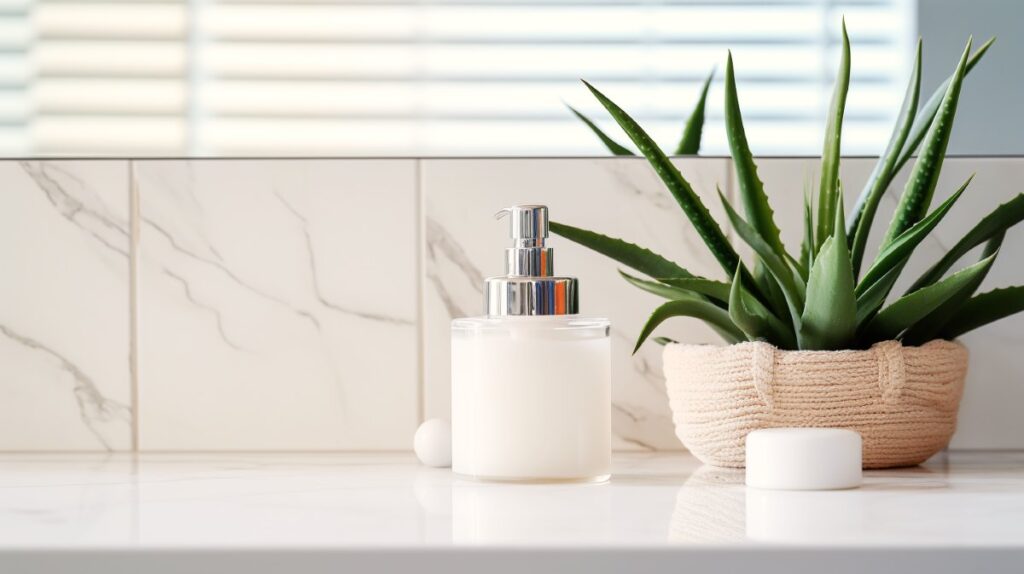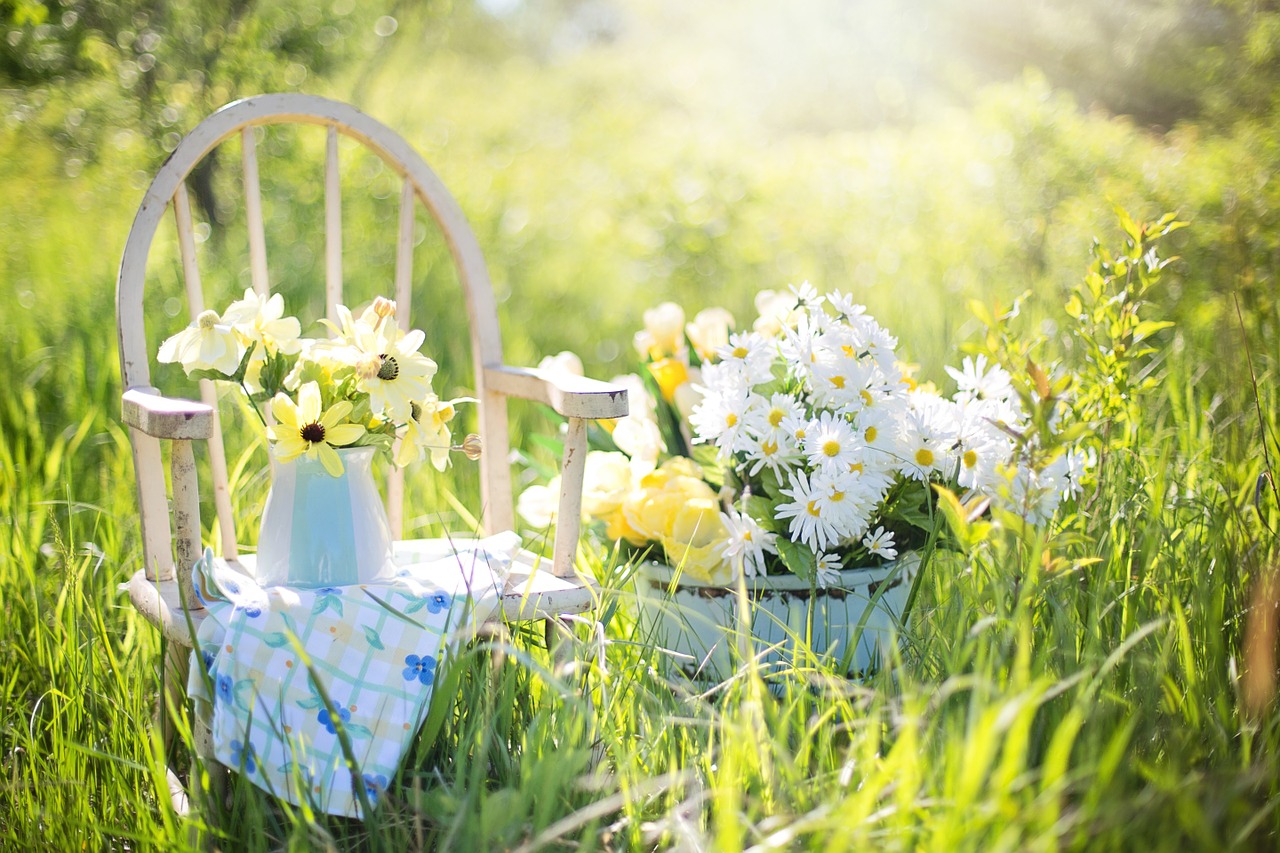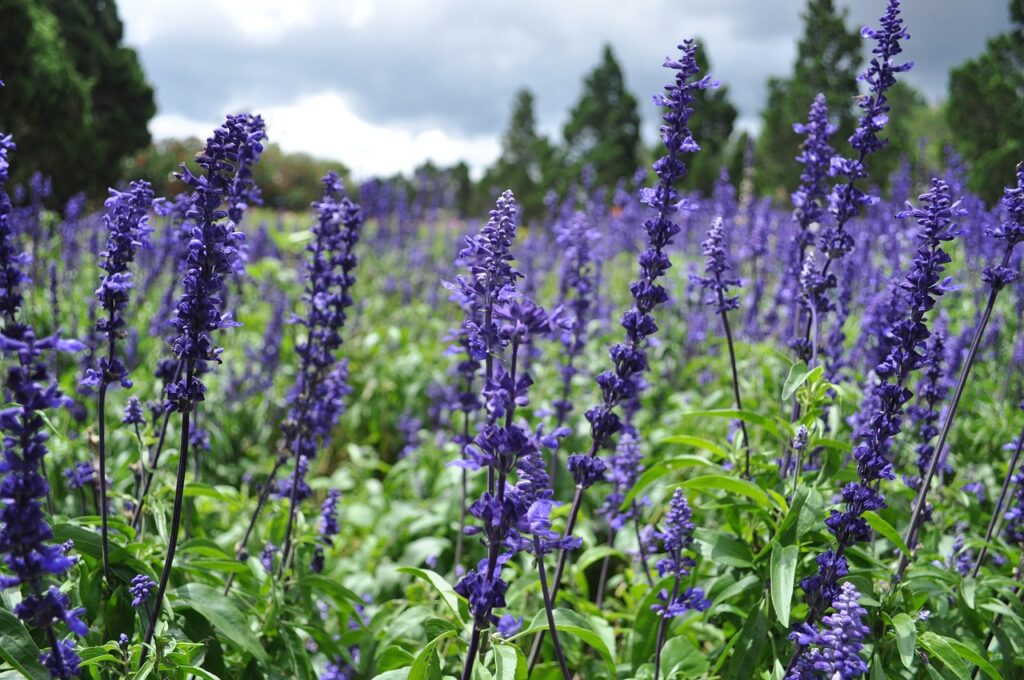Aloe Moisturizer DIY: 3 Simple Recipes for Skin Hydration
Creating your own aloe moisturizer can be a rewarding and natural way to keep your skin hydrated and healthy. Aloe vera, known for its soothing and healing properties, is an excellent DIY moisturizer base. This straightforward approach to skincare lets you control the ingredients, ensuring a pure and chemical-free product that caters to your skin’s specific needs.
- Aloe Vera in Skincare
- Benefits for Skin
- 3 DIY Aloe Moisturizer Recipes and Guide
- Optimizing for Best Results
- Preservation and Storage
- 5 Essential Oils to Add to Your DIY Aloe Moisturizer
- Aloe Moisturizer FAQs
- How can you create a moisturizing cream for your face using fresh aloe vera?
- What ingredients can be mixed with aloe vera for a DIY moisturizer suitable for oily skin?
- Can I use aloe vera if I have acne?
- Which natural oils, such as coconut or shea butter, can be combined with aloe vera to enhance facial moisturizers?
- Is it possible to use pure aloe vera as a moisturizer, and are there any skin types that should avoid it?
- What is the process for making an aloe vera gel-based hair moisturizer?
- Can homemade aloe vera moisturizers cater to the needs of those with dry skin, and what specific ingredients help?
- What kind of aloe do I need to buy for my DIY aloe lotion?
- Which essential oils are the best to use with aloe vera?
- Why should I use aloe vera instead of other skincare ingredients?
When making your own aloe moisturizer, you’ll join countless other DIY enthusiasts who value the effectiveness and simplicity of homemade skincare products that contain only natural ingredients. The process not only saves money but also allows for customization based on your skin type, whether that’s oily, dry, or somewhere in between.
With just a few natural ingredients, you can create a versatile moisturizer suitable for daily use.
Aloe Vera in Skincare
Aloe Vera stands out for its nourishing and moisturizing benefits as an integral component of skincare routines. Drawn from a succulent plant with a long-standing medicinal reputation, its gel and juice are skincare staples for their soothing benefits.
Botanical Profile of Aloe Plant
The Aloe Vera plant is a succulent species renowned for its thick, fleshy leaves, which harbor a clear, gel-like substance. This perennial boasts a rich history as a medicinal plant and thrives in arid climates around the globe. Its leaves contain two main components: the gel, which is used primarily in skincare, and the latex, a yellowish substance found just under the skin of the leaf.
Latin Name: Aloe barbadensis miller
Origins: Predominantly found in Africa, the Mediterranean, and the Arabian Peninsula
Physical Characteristics:
- Succulent leaves with a protective outer layer
- Gel-filled center leaf tissue
Aloe Vera Gel and Juice
Aloe Vera gel is the clear, jelly-like material found within the inner part of the aloe plant leaf. It’s composed of water, vitamins, minerals, and several other beneficial compounds. This gel has been shown to have anti-inflammatory properties, making it helpful for soothing skin irritations and burns.
Components of Aloe Vera Gel:
- Water
- Vitamins including A, C, and E
- Minerals
- Enzymes
- Amino Acids
- Salicylic Acids
Conversely, Aloe Vera juice is made by crushing or grinding the entire leaf of the aloe vera plant, followed by various steps to purify and filter the liquid. With a mild, tolerable flavor, the juice mixes easily into smoothies and shakes.
Traditional Usage in Skincare
For centuries, cultures around the world have utilized aloe vera for its healing properties in skincare. Its moisturizing effect and ability to reduce skin inflammation make aloe vera a valuable remedy for conditions like psoriasis, acne, and eczema.
Historical Skincare Uses:
- Moisturizing dry skin
- Treating burns and cuts
- Soothing skin irritations
- Improving skin elasticity
When you apply aloe vera gel directly to your skin, it can help combat common skin troubles, providing a gentle, natural treatment option.
Benefits for Skin
Incorporating aloe into your skincare routine can significantly enhance your skin’s health. It targets specific skin concerns, from offering deep hydration for dry skin to soothing skin irritation.
Hydrating Dry Skin
Aloe vera provides deep hydration to your skin. It’s especially beneficial if you have dry skin, as it helps to lock in moisture without leaving a greasy residue. That’s why we like aloe in particular: there’s zero greasy residue.
Soothing Sensitive and Itchy Skin
For those with sensitive or itchy skin, aloe’s calming properties reduce discomfort and inflammation. It’s a natural remedy that supports healthy skin by alleviating common skin problems. We deal with eczema in our family, and aloe is a fantastic ingredient to add to DIY lotions or even for applying directly to irritated skin.
Multiple studies recognize aloe vera’s role in skincare for the many diverse benefits it provides.
3 DIY Aloe Moisturizer Recipes and Guide
Creating your own moisturizer can be a rewarding way to take control of your skincare. These DIY aloe vera moisturizer recipes are simple to follow and cater to different skin types and needs, offering a potent way to hydrate and nourish your skin using the natural benefits of aloe vera.
Common Ingredients and Options
To craft your homemade aloe vera moisturizers, you’ll primarily need fresh aloe vera gel or store-bought pure aloe gel.
Depending on your skin type, you can enhance your DIY recipes with various oils.
- For oily skin, consider lighter oils like jojoba or sweet almond oil.
- For dry skin, more nourishing oils like coconut or olive oil might be beneficial. Body butter containing shea or cocoa butter also works very well.
Optional additions such as vitamin E, essential oils, or vegetable glycerin can provide plenty of extra benefits.
Tools and Preparation Tips
Before making your own DIY aloe moisturizer, prepare by getting a few simple tools for mixing and storing. Here’s a quick list:
- A bowl for mixing
- A whisk or blender for thorough mixing
- Measuring spoons or cups
- A container for your finished moisturizer
Ensure all tools are clean to prevent contamination. Have your ingredients measured and prepared before beginning to make the process efficient.
1.) Light and Refreshing Aloe Vera Face Cream
For a light facial moisturizer:
- Mix 2 tbsp of aloe vera gel with 1 tsp of jojoba oil.
- Blend until smooth.
- Transfer to a container.
This homemade face cream is ideal for everyday use, providing a refreshing and light touch to nourish your facial skin without leaving it greasy. It’s also a perfect recipe to double for a larger batch.
We didn’t include any essential oils in this recipe since many people looking to use aloe likely have sensitive skin. However, we love using essential oils for their own skincare benefits. If you have sensitive skin, try this simple recipe first, check for skin irritation after a few days, then add your essential oils in the next batch.
2.) All-body Aloe Vera Moisturizer and Body Lotion
For a body lotion:
- Combine 1/4 cup aloe vera gel, 1/4 cup almond oil, and 1/4 cup coconut oil in a double boiler.
- Once melted and combined, allow to cool.
- Transfer to a jar and let it solidify.
This homemade cream is perfect for all-body application, giving your skin a hydrating boost from the antioxidant-rich aloe gel. Add a few essential oils as well, like lavender, sandalwood, or even palmarosa.
3.) Aloe Vera Nourishing Body Butter
For extra nourishment:
- Whisk together 1/2 cup aloe vera gel, 1/2 cup shea butter, and 2 tbsp olive oil (almond or jojoba oils also work fine) until creamy.
- Optionally, add a few drops of your favorite essential oil.
- Store in a cool, dry place.
This luxurious DIY aloe vera body butter can double as a robust body butter for areas needing extra care, leaving your skin soft and well-moisturized. For some additional reading on essential oils you could add to this mix, check out our post here: 14 Best Essential Oils to Mix with Shea Butter.
Optimizing for Best Results
Creating an effective DIY aloe moisturizer hinges on balancing its components for the best skin compatibility and performance. For example, careful attention ensures that a good face moisturizer feels great and isn’t too heavy or greasy.
Understanding the Right Consistency and pH
Achieving the correct consistency of your DIY aloe moisturizer is crucial since it affects how well the product will penetrate your skin pores.
Aim for a balance between the oil and water phases to ensure optimal absorption without leaving a greasy residue unless you aim for a heavy body-butter-like result. Body butters are supposed to be heavy, face creams should be on the lighter side, and body lotions should be somewhere in between.
Additionally, maintaining a skin-friendly pH, typically around 4.5 to around 7, is essential to prevent irritation and maintain the skin’s natural moisture barrier.
Customizing Recipes for Different Skin Types
- For dry skin, enrich your moisturizer with ingredients like hyaluronic acid or shea butter for additional hydration.
- If your skin is oily, consider a lighter oil, such as grapeseed or jojoba, to moisturize without clogging pores.
- Those with sensitive skin should opt for soothing components like chamomile or calendula to prevent irritation.
Each skin type benefits from an individually tailored approach that considers its unique needs while harnessing the natural benefits of aloe vera.
Preservation and Storage
To ensure your homemade aloe vera moisturizer remains effective and safe for use, preservation and storage are two key factors.
Ensuring Long Shelf Life
To maximize the shelf life of aloe vera gel, consider adding natural preservatives such as vitamin E, citric acid, or a drop or two of rosemary essential oil. These can help inhibit microbial growth and oxidation.
- Vitamin E: A natural antioxidant, mix about 1/4 teaspoon with 1 cup of aloe gel.
- Citric Acid: Works as a preservative, use 1/8 teaspoon per cup of gel.
- Rosemary Essential Oil: Add 4-6 drops per ounce of finished solution.
Proper Storage
Always store your aloe vera moisturizer in an airtight container to prevent contamination and drying out. The ideal storage is a cool place, such as a refrigerator, which can extend the shelf life to a few weeks.
If you must keep it at room temperature, try to use your lotion within a week or so and use essential oils to extend the shelf life.
5 Essential Oils to Add to Your DIY Aloe Moisturizer
Here are five essential oils that are known for their skin-loving benefits and would make a great addition to your DIY aloe moisturizer:
- Lavender Essential Oil: As we mentioned a few times, lavender is perfect for calming both your skin and your senses. It’s gentle and can help soothe minor irritations.
- Tea Tree Essential Oil: If you’re looking for something to help with blemishes, tea tree oil has purifying qualities that can assist in keeping your skin clear.
- Frankincense Essential Oil: For a touch of luxury, frankincense can help to rejuvenate and refresh your skin’s appearance.
- Geranium Essential Oil: Geranium has a balancing effect and can be great for both dry and oily skin types.
- Rosemary Essential Oil: Invigorating rosemary can help to refresh tired skin and improve your overall complexion.
Remember, when you’re mixing up your own aloe moisturizer, a little goes a long way with essential oils. Just a few drops of these potent botanicals can lend their properties to your moisturizer, making it a special part of your daily routine.
Enjoy the process of creating and the pleasure of using a product that’s tailored just for you.
Aloe Moisturizer FAQs
How can you create a moisturizing cream for your face using fresh aloe vera?
To create a moisturizing cream, harvest the gel from a fresh aloe vera leaf and blend it with any quality natural skin-friendly oils like jojoba, argan, hemp seed, rosehip, or sweet almond oils. Use more oil for a heavier moisturizer and more aloe for something more akin to a face cream.
What ingredients can be mixed with aloe vera for a DIY moisturizer suitable for oily skin?
Mix aloe vera gel with non-comedogenic oils like argan or jojoba oil for oily skin to create a lightweight moisturizer.
Can I use aloe vera if I have acne?
Yes, aloe vera has anti-inflammatory properties and can be used on acne-prone skin; it may help soothe and reduce redness. Check out our post here for more info: DIY Aloe Vera Moisturizer for Acne: 3 Simple Recipes.
Which natural oils, such as coconut or shea butter, can be combined with aloe vera to enhance facial moisturizers?
Those two are just fine, as well as others mentioned in the first answer above and mentioned in this post.
Is it possible to use pure aloe vera as a moisturizer, and are there any skin types that should avoid it?
Pure aloe vera can be used as a moisturizer. It’s quite gentle when used directly on the skin. Since everyone is different, though, test on a small patch of skin first to be extra cautious.
What is the process for making an aloe vera gel-based hair moisturizer?
For hair moisturizer, blend aloe vera gel with a carrier oil and apply it to the hair, focusing on the ends to hydrate and tame frizz. Search our website for “hair moisturizer,” and you should find at least one post with more information.
Can homemade aloe vera moisturizers cater to the needs of those with dry skin, and what specific ingredients help?
Yes, for dry skin, enhance homemade aloe vera moisturizers with rich oils such as avocado oil or ingredients like manuka honey for added hydration.
What kind of aloe do I need to buy for my DIY aloe lotion?
For DIY aloe lotion, use 100% pure aloe vera gel or directly harvested aloe from the plant for best results.
Which essential oils are the best to use with aloe vera?
Essential oils like lavender, tea tree, and chamomile work well with aloe vera, offering added benefits and pleasant scents.
Why should I use aloe vera instead of other skincare ingredients?
Aloe vera is a versatile plant with moisturizing and soothing properties, making it an excellent choice for various skin types. It’s watery, light, non-greasy, and has demonstrated skin benefits in numerous studies. It’s been used for thousands of years and is a solid skincare ingredient for those reasons.


